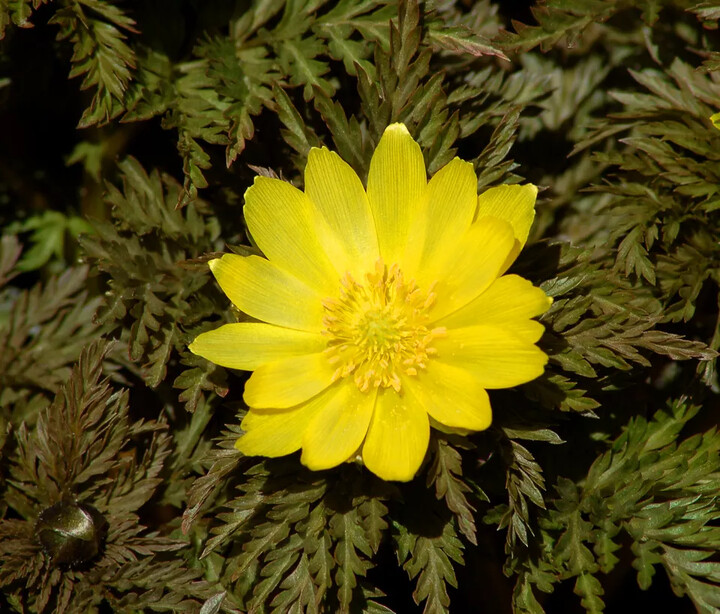Amur adonis is one of the first plants to bloom in spring. That is no small consideration for Northern gardeners starved for some landscape color after the long winter. This perennial is grown mainly for its waxy, yellow flower, but the fern-like foliage is also attractive. The flowers are 1 to 2 inches across and come out before the foliage appears. The wonderful flower color is sometimes said to be "buttercup yellow," an apt description since the plants belong to the Ranunculus (Buttercup) family. 
Botanical Name:
Adonis amurensis. One of the chief cultivars is 'Fukujukai.'
Common Name:
Amur adonis
Plant Type:
Herbaceous perennial
Mature Size:
1 foot tall (with a somewhat greater spread)
Sun Exposure:
Full sun to partial shade
Soil Type:
Well-drained
Soil pH:Slightly acidic to slightly alkaline
Bloom Time:
March or April in zone 5
Flower Color:
Yellow
Hardiness Zones:
3 to 7
Native Area:
Northeastern Asia
How to Grow Amur Adonis
Amur adonis is easy to grow, but being a spring ephemeral, it does go dormant when summer comes. So your main challenge in growing it is a design challenge: You have to figure out how to plug the "holes" left in your garden after the Amur adonis plants make their annual exit. One solution is to buy annual flowers and plant them around the holes left behind. If you do not want to have to remember to take this step every year, simply grow other perennials around your Amur adonis plants that fill out and bloom later in the year. Make sure that such plants are compatible with Amur adonis in terms of sun and soil conditions.
These clump-forming perennials can be divided for propagation when they go dormant in summer.
Light
Although Amur adonis will tolerate partial shade, it grows best in full sun.
Soil
Grow Adonis in fertile, well-drained soil.
Water
Keep the soil for this perennial evenly moist.
Fertilizer
Feed the plant annually by working compost into its soil.
Uses for Amur Adonis in the Landscape
Ensure that, once the snowdrifts of the winter retreat, you have plants in your garden that will supply plenty of color to the spring landscape. Spring bulb plants such as snowdrops (Galanthus nivalis) naturally come to mind, but a few perennials, such as Amur adonis, are also useful in this regard. Another is the pasque flower (Pulsatilla vulgaris), which blooms a little later and offers lavender-colored flowers.
Amur adonis plants are well-suited to rock gardens.
Origin of the Name
In Greek mythology, Adonis was a Greek youth loved by Aphrodite. But Adonis was gored by a boar and died. Through the power of the mourning goddess, a red flower sprang up from the youth's blood on the spot. There are similar Greek myths regarding the daffodil (Narcissus) flower and the hyacinth flower (Hyacinthus orientalis), for example.
But there can be a twist in these stories for us moderns: The flower of the myth is not always the flower that we know by the same name. It is not in this case: What we call the "Adonis flower" is not the flower referenced in the Greek myth. That honor belongs to the red windflower (Anemone). The "Amur" part of the name derives from the name of a river in Northeastern Asia (to which the plant is native).
Newcomers to gardening may confuse the name of Adonis flowers with a type of butterfly bush (Buddleia davidii) called "Adonis Blue." But the two are, in fact, totally unrelated.
Varieties of Adonis
Most types of adonis are perennials; some, however, are annuals. Adonis aestivalis (sometimes given as Adonis annua) and Adonis autumnalis are annuals that bear red flowers with a black center. Their common name, "pheasant's eye," derives from the fact that their red flowers are reminiscent of the red eye patch that the male pheasant sports.
Interestingly, Adonis vernalis and the other yellow-flowered members of this genus are also sometimes called "pheasant's eye," in spite of their flower color; perhaps they picked up the nickname by association with the red adonises. Some people are more precise when using this common name for Adonis vernalis and the other yellow-flowered adonises and specify "yellow pheasant eye." Adonis vernalis, a native of Europe and Asia, is also sometimes called "false hellebore."
If you had to pick a "real Adonis" from among this genus, it would have to be one of the annual types: Since they bear red flowers, they relate more closely to the myth of Adonis than do the yellow-flowered types. The anemone in the myth is, after all, red in color, symbolic of the blood of the slain youth.
But the red anemone and the red adonis are, in fact, similar in appearance. That is not surprising, since the Anemone and Adonis genera are related, botanically, both being in the Ranunculus family. From this similarity in appearance, it was not too big a leap to pay a fitting tribute to the myth and name the genus "Adonis."
You Might Like ...